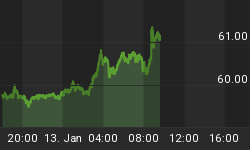Two Unique Charts Reveal the Answer
Robert Prechter, New York Times best-selling author and renowned market analyst, was recently asked to present his thoughts on the real estate market and the financial crisis to the Georgia Legislature. The following article has been adapted from the transcript. Elliott Wave International has made the full presentation available free, including the full transcript and 30-minute online video.
I'd like to try to answer a question: "Are we near a low in the stock decline?" Because in these times when stocks and real estate are declining together, they tend to bottom roughly together as well. So I want to take a minute and look at a valuation chart for the stock market.

What we have here on the "X" axis is the bond yield/stock yield ratio for the S&P 400 companies. Sounds fancy, but all it means is that the further you go out to the right, the less companies are paying in dividends compared to what they are paying on their IOUs -- on their bonds. On the "Y" axis we have stock prices relative to book value. Book value is roughly equivalent to liquidation value, in other words, if you went and sold all the assets on the open market. When stocks get expensive, prices tend to rise relative to book value, and dividends tend to fall relative to the cost of borrowing. Why does that happen? At such times, people don't really care about dividends because they think they are going to get rich on capital gains. So dividend payout falls, and stocks get more expensive.
The small square boxes indicate year-end figures. The large box is a general area that has contained values for the stock market for most of the years of the 20th century. We had a few outliers: 1928 and August 1987, which preceded crashes in the stock market. And of course stocks were really cheap in the early '30s and again in 1941. If you are really astute, you have noticed something about this chart, which is that I've left off some of the data. It ends in 1990. What happened in the past two decades? Now I'm going to show you same chart but with the data from the last two decades on it. The March 2000 reading we call Pluto. Real estate wasn't so bad; I think it only got to about Neptune. But the stock market reached Pluto in March of 2000 in terms of the bond yield/stock yield ratio and the price multiple of the underlying values of companies. That's going to take quite awhile to retrace.

I've also plotted the reading for November 2008. The market has made quite a trek back toward normal valuations, but if you look at these multiples in terms of book value, we are at 4 times. It has to go down to 2 times to get back into the box, and we are getting there on the bond yield/stock yield ratio which means that the dividend payout is rising somewhat to catch up with borrowing costs. And because the S&P is down 45%, of course, the dividend payout as a percentage has gone up. But there is a problem there. If you're reading the newspapers, you know that companies have been cutting dividends. In fact, they've been cutting them at the fastest rate in half a century. So it is going to be difficult for values to get back to a normal valuation range. So the stock market has quite a bit lower to go in order to catch up with normal values, and this suggests that real estate may have the same sort of trend going on.
For more information, access Robert Prechter's full presentation to the Georgia Legislature, free from Elliott Wave International. It expands on the excerpt above with the full transcript, a 30- minute online video, and 12 additional charts and figures.















